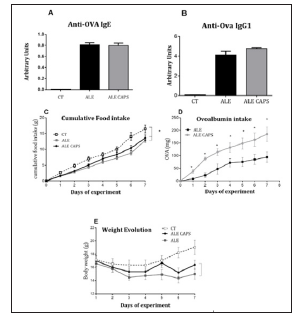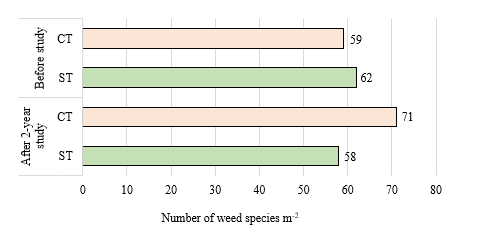Topical Application of Capsaicin Reduces Weight, Loss Allergen Aversion and Intestinal Mucosa Inflammation in A Food Allergy Experimental Model
Abstract
Food allergy consists of a disease characterized by vomiting, weight
loss, dehydration, and activation of inflammatory mediators in the
intestinal mucosa. Capsaicin, the spicy component of pepper, is already
described as an analgesic and anti-inflammatory agent. This pilot study
evaluated the effect of the topical use of capsaicin on a food allergy
model. Ovalbumin allergic mice (OVA) treated topically with a 100 mg of
capsaicin cream (0.075%) or control capsaicin-free cream were challenged
with OVA solution (20%) for 7 days. Body weight, food and antigen (OVA)
intakes were evaluated daily. Anti-ova IgG and IgE, neutrophil,
eosinophil, and macrophage intestinal infiltration and mucus production
were measured after both treatments. The results showed that allergic
mice treated with topical capsaicin presented higher allergen tolerance,
lower weight loss, reduced eosinophils and neutrophils intestinal
infiltration and decreased mucus production compared to non-treated
mice. Despite the higher intake of allergen by capsaicin-treated mice,
circulating IgE and IgG antibodies concentrations were similar in both
groups. We concluded that topical treatment with capsaicin attenuates
the intensity of food allergy symptoms, suggesting a beneficial action
in this disorder.
Keywords: Capsaicin; Food Allergy; Oral Tolerance
Abbrevations: TRPV1: transient receptor
potential vanilloid 1 OVA: ovalbumin; MPO: myeloperoxidase EPO:
eosinophil peroxidase; NAG: enzymes and n-acetylglucosaminidase TCR:
T-cell receptor; TNF: Tumor Necrosis Factor IL: Interleukin; IFN:
Interferon; PPAR: peroxisome proliferator-activated receptor gamma LXR:
Liver X receptor
Introduction
Food allergy is an atopic disease, affecting children and adults
around the world [1]. It develops when there is a failure on the
induction or breakdown in oral tolerance. Due to the increasing
incidence of food allergy, researches on preventive actions, including
nutraceuticals agents, are growing in the literature [2,3] Capsaicin
(8-methyl-N-vanillyl-1-6-nonenamide) is a spicy substance found in
chilies (Capsicum frutescens and Capsicum annum), with an important role
in cooking. Capsaicin is a highly selective agonist for the transient
receptor potential vanilloid 1 (TRPV1), a nonselective cation channel,
preferably expressed by primary afferent sensory neurons of the pain
pathway. This characteristic makes capsaicin potentially useful on the
treatment of chronic pain [4-7]. Capsaicin creams for topical
application have
been commercialized to treat some inflammatory disorders. The efficacy
of such an administration via has been demonstrated in studies of pain
relief related to arthritis, postoperative neuralgia, diabetic
neuropathy, and psoriasis [4,8]. Thus, we aimed to evaluate the effect
of the topical use of capsaicin in a model of food allergy chronic l
characterized by a ow-grade mucosa intestinal inflammation.
Materials and Methods
This study was approved bt the Ethical Committee for Animal Studies
of Federal University of Minas Gerais (protocol CEUA/UFMG 78/2012).
Female Balb-C mice aged 5 to 8 weeks with sanitary status SPF (Specific
Pathogen Free) were obtained from the animal
facility of the Federal University of Minas Gerais, Brazil. The animals
were kept in a controlled environment with 12 hours of light and
dark cycle and temperature about 28 °C (± 2 °C), with free access
to food and liquids. During the challenge period (allergen intake),
animals were kept in individual cages for better control of allergen
intake. Food allergy was induced according to the model described
by Saldanha et al. [9]. Briefly, a solution containing 10 μg of
ovalbumin (OVA) 98%, 1 mg of adjuvant (aluminum hydroxide) and
0.2 ml of 0.9% saline solution was administrated subcutaneously
on the back of the animal. After 14 days, a sensitization boost
containing 10 μg of OVA without adjuvant was administered. The
experimental period started 7 days after the sensitization boost, by
replacing water for an OVA solution (20%). Animals were divided
into the ALE group, treated topically with base cream (without
capsaicin) and ALE CAPS group, which received the same base
cream containing 0.075% capsaicin (v/v). Mice, without allergy
induction or topic treatment were used as healthy controls.
Mice had part of their back shaved for daily the application
daily of 100mg of the respective creams in an area of approximately
1 cm2 days during 7 days, according to a previous protocol [10].
Food and liquid intakes were measured daily by the difference of
the quantity offered and the rest. All animals were euthanized on
the 8th experimental day and blood, and small intestine samples
were withdrawn for further analyses. Blood were used for the
quantification of anti OVA IgE and IgG1 antibodies concentration
by ELISA kits to confirm allergy induction. The evaluation of
the cellular infiltrate of the small intestine was made by the
myeloperoxidase (MPO), eosinophil peroxidase (EPO) enzymes
and n-acetylglucosaminidase (NAG) activities, as indirect measure
of neutrophils, eosinophils, and macrophages, respectively.
Histopathological analysis of the goblet cells producing mucus was
performed in the small intestine by the periodic acid from Schiff
(P.A.S) stain using the Image J. Software (NIH, USA). PAS positive
pixels were selected for the calculation of the total area mucusproducing
goblet cells. The result was expressed as % of P.A.S
positive area of intestinal mucosa/field. The data were evaluated for
normal distribution by the Kolmogorov-Smirnov test. Parametric
and non-parametric data were submitted to Student’s t-Test and
Mann Whitney test, respectivelly. The results were expressed as the
mean and standard error. Statistical analyzes were performed using
GraphPad Prism 7.0® software (San Diego, CA, USA). The level of
significance was set at p< 0.05.
Results
The results of blood concentration showed that anti OVA IgE
and IgG1 antibodies levels were compatible with the presence of
OVA allergy. However, no difference was detected between ALE and
ALE CAPS groups considering IgE or IgG1 concentrations (Figure
1). Although IgE and IgG1 levels were similar in both groups, the
OVA solution intake, in turn, was higher in animals treated with
topical capsaicin, showing a higher tolerance to the allergen (Figure
1). Food intake was reduced compared to healthy mice, but similar
in allergic groups confirming a similar caloric intake between ALE
and ALE CAPS groups. Nonetheless, ALE CAPS mice showed a
better body weight evolution, with a weight loss lower than in ALE
group during the experimental days (Figure 1). When the intestinal
inflammatory infiltrates were analyzed, it was noted that the ALE
CAPS group showed lower neutrophil and eosinophil infiltration,
as suggested by the MPO and EPO activity, respectively (Figure
2). No difference was seen when the macrophage infiltration was
compared (p= 0.064). ALE group exhibited hypersecretion of
mucus by goblet cells. However, a smaller mucus production was
observed in allergic animals treated with capsaicin when compared
to allergic animals (Figure 3).
Figure 1: Evaluation of blood levels of IgE (A) and IgG1 (B), cumulative food intake (C), ovalbumin intake (D) and weight
evolution (E) in ovalbumin allergic mice topically treated with capsaicin-free cream (ALE), 0.075% capsaicin cream (ALE
CAPS) or in mice without allergy or capsaicin treatment (CT). The results were expressed as mean and SD. SD. N= 7/group. *
Statistically significant (p < 0.05).

Discussion
Our results suggest a beneficial effect of the topical application
of capsaicin in reducing the manifestations of food allergy. Due to its
lipophilic character, capsaicin can be absorbed from the skin, with
a half-life of about 24 hours [4]. This route of administration has
already been used in commercial products to help relieve a several
types of minor neuralgia related to disorders such as rheumatoid
arthritis or muscle sprains and strains [11, 12]. Two of the major
signs of food allergy are weight loss and allergen aversion [13,14].
Our results show that capsaicin can reduce both since the ALE CAPS
group presented higher intake of OVA solution and lower weight loss
compared to ALE mice. The improvement in allergy in the capsaicintreated
group was also demonstrated by the lower recruitment of
neutrophils and eosinophils to the small intestine. Neutrophils
are the first cells to be recruited to the site of inflammation, being
installed in the lamina propria and intestinal crypts, releasing
the enzyme myeloperoxidase (MPO) among other components
[15]. Eosinophils are fundamental cells in the allergic process,
serving as “immunological effector sentinels”, with rapid action in
inflammatory processes [13, 16]. In allergic diseases, eosinophils
are activated and attracted to the intestinal mucosa, releasing the
degranulation products such as toxins and free radicals, which can
trigger intestinal injury. The release of leukotrienes and cytokines
by eosinophils amplifies the inflammatory response, recruiting and
activating more eosinophils. The mucosa eosinophil infiltration in
others intestinal disorder such as inflammatory bowel diseases
is associated with unfavorable conditions such as malabsorption,
weight loss and changes in mucosal architecture with decreased
crypts in the colon and villous flattening [16-18].
These results suggested that topical capsaicin is acting as
an anti-inflammatory agent creating a less inflamed intestinal
environment. Another important feature of food allergy is the
increased production of mucus by goblet cells [13]. It is known that
in the late phase of food allergy, eosinophils release lipid mediators
such as prostaglandin D2, which increase mucus production by
intestinal goblet cells [13]. Our data suggested that the lower
production of mucus in the ALE CAPS group could be the result of
the lower eosinophil infiltration in this group and its lower release
of lipid mediators. Our data agree with the hypothesis that topical
capsaicin would act mainly in the late phase of food allergy leading
to the lower infiltration of inflammatory cells. Although the antiinflammatory
action of capsaicin has been described in several in
vitro studies, the mechanisms are not fully understood [4,19,20].
One of the possible mechanisms is related to the action of capsaicin
as a TRPV1 ligand [21].
It has been described that for the complete activation of the
TRPV1 vanilloid channel, about 10μM of capsaicin is required
[22-26]. When activated, TRPV1 channels are associated with
thermal hyperalgesia in the skin, visceral organs and oral cavity
[21]. However, repeated exposures to capsaicin, as occurred in
the present study, cause effects of analgesia due to the nociceptor
desensitization or a calcium-dependent extracellular reduction and
TRPV1 responsiveness [4,22,23,26-29]. This inhibition, in turn,
regulates T-cell receptor (TCR) -mediated T cell activation with the
production of anti-inflammatory cytokines through the suppression
of TNF- α, IL-2 and IFN-α [30]. Capsaicin appears to be also a direct
agonist of the peroxisome proliferator-activated receptor gamma
(PPAR) that can stimulate the liver X receptor (LXR) expression
in an anti-inflammatory pathway, independent of TRPV1 activation
[20,21]. These results are in agreement with those of Lee, Shin et
al. who observed lower expression of proinflammatory cytokines
in obese mice topically treated with capsaicin, reinforcing the
regulatory role of capsaicin on inflammation [10]. Although all
parameters demonstrated improvement of food allergy symptoms
with topical use of capsaicin, IgE and IgG1 concentrations were
similar between groups. However, due to the 3 and 23-day halflives
of these immunoglobulins, respectively [31], the treatment
time (7 days) may not have been sufficient to detect significant
changes in their plasma levels. Alternatively, if capsaicin somehow
interferes with IgE binding with its FcRI receptor rather than
reducing IgE production, no difference in the circulating levels of
that immunoglobulin would be detected.
Conclusion
Our data suggest that the topical application of capsaicin is
associated to positive effects in food allergy related to reduction of
major manifestations, such as allergen aversion and body weight
loss.
Influence of Muscle Fatigue on Three-Dimensional
Scapular Kinematics During Repeated Arm Elevation - https://biomedres01.blogspot.com/2020/02/influence-of-muscle-fatigue-on-three.html
More BJSTR Articles : https://biomedres01.blogspot.com


No comments:
Post a Comment
Note: Only a member of this blog may post a comment.